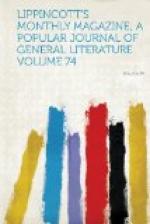diplomat, an ambassador to more than one foreign court,
is now a cab-driver, and not a particularly good one.
Unfrocked priests, unsuccessful school-teachers, small
bankrupt tradesmen, swell the ranks, the personnel
of which is mainly composed of servants out of place
or of provincials who have come to Paris to seek their
fortune. These last come mostly from Normandy,
Auvergne and Savoy; and it has been noticed that the
Savoyards are the most sober and docile of all.
The Parisian cabman is always under the surveillance
of the police: a policeman stationed on every
stand watches each cab as it drives off, and takes
its number to guard as far as possible against any
overcharge or peculation. In case of a collision
and quarrel or an accident the ubiquitous policeman
is always at hand to take the numbers of the vehicles
whose drivers may be concerned in the affair.
Complaints made by passengers are always attended
to at once, and immediate redress is pretty sure to
follow. The cabman is generally gruff and surly,
and, though seldom seen drunk, in the majority of
cases is addicted to drink—a vice which
the exposed nature of his calling palliates if it
does not wholly excuse. Some cabmen are devoted
to newspaper reading, and may be seen engaged perusing
the Rappel or the Evenement while awaiting
the appearance of a fare or stationed before the door
of a shop or a picture-gallery. Others prefer
to nap away their leisure moments, and may be seen,
half sitting, half lying on their boxes, and sound
asleep. It is rather a curious process to pass
slowly along the line of a Parisian cab-stand and
observe the faces of the men. Every variety and
type of countenance—from the Parisian “Jakey”
with villainous eyes, sharp features and black soaplocks,
to the jolly old patriarch, gray and stout, and somewhat
stiff in the joints, who has been a cab-driver for
over forty years perhaps—presents itself
to your view. The best way to engage a cab is
by observing the face of the driver, not the condition
of the vehicle or that of the horse. The Parisian
cabmen wear no uniform, the high glazed hat being
the only article of attire which is universally adopted.
Even the red waistcoat, once a distinctive mark of
their calling, is gradually falling into disuse, and
every variety of coat and overcoat may be seen, liveries
past private service being very generally adopted.
Any overcharge may be reclaimed by the passenger by
the simple process of making a complaint before the
nearest chef de police. In past days the coachman
thus complained against was forced to go in person
to the complainant to beg his or her pardon, and to
pay over the extra sum demanded. A frightful
catastrophe which occurred some twenty years ago put
an end to this form of retribution. On the 16th
of September, 1855, M. Juge, director of the normal
school at Douai, took a cab in the Place de la Concorde
and went for a drive in the Bois de Boulogne.
The driver, one Collignon, insisted on being paid more




